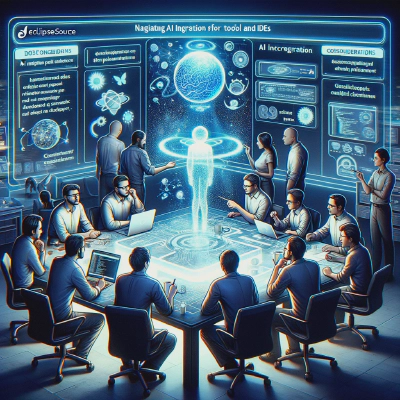Jonas Helming, Maximilian Koegel and Philip Langer co-lead EclipseSource, specializing in consulting and engineering innovative, customized tools and IDEs, with a strong …
Why Every Tool and IDE Project Should Care About AI Integration
February 26, 2024 | 10 min ReadFor creators of custom tools and Integrated Development Environments (IDEs), AI integration is not just a fleeting trend or an additional feature to consider. It is a paradigm shift, capable of revolutionizing user interaction and exponentially boosting productivity. At EclipseSource, we have observed a growing demand in tool projects to develop strategies that harness the benefits of AI. In this article, we will explore why AI is essential in tools and IDEs and the important initial considerations for its integration.

Use Cases of AI in Tools and IDEs are endless
AI’s potential in tools and IDEs is vast and varied. Imagine an IDE that co-develops test cases to the code you are currently writing, revealing potential bugs before they occur. Or think of an assistant that implements entire features based on a natural language description and further predicts how other parts of the software, including documentation, need to be adapted when you perform a certain task. Another use case could be an AI-driven interface that intelligently triages, combines, summarizes and prioritizes bug reports and support requests based on certain criteria, such as impact, component, or location in the source code. Consider also a capability enabling users to pre-configure complex hardware just by describing their desired outcomes in natural language. Instead of navigating through the documentation of thousands of parameters, the AI interprets the users’ needs and automatically sets the configuration considering all dependencies and constraints and thereby simplifying what would otherwise be a daunting task. These are not far-fetched scenarios; they are real possibilities with AI. However, these examples barely scratch the surface of AI’s capabilities. By integrating AI, tools and IDEs can offer unprecedented levels of support and efficiency, transforming the way users interact with their toolchain.

Key Considerations for AI Integration
Developing gainful and well-designed AI integrations for tools and IDEs is a paradigm shift for tool creators as well. The integration of AI in tools and IDEs is a journey unique to each project, presenting distinct challenges and often requires customized solutions. At EclipseSource, we understand that one-size-fits-all approaches do not work in the world of AI integration. This is why our services are meticulously tailored to meet the specific needs of each project, and may range from clever tool integrations to fine-tuning and training of custom language models or learning algorithms. Given the novelty of this field, many of the innovative solutions we are currently developing are not yet in the public domain.
However, despite the uniqueness of each project, certain questions and considerations are almost universally relevant for those embarking on AI integration into tools. To assist those navigating this new terrain, we offer insights and guidance based on our experience with various clients. These shared experiences and considerations are crucial for anyone looking to integrate AI into their tool or IDE project.

Selecting the right use cases for AI Assistance
When initiating the integration of AI into tools and IDEs, it’s crucial to pinpoint the most suitable use cases. This task varies significantly depending on the specificities of each project, yet there are some common critical factors to consider:
Feasibility Analysis: Determining whether a use case is realistically addressable by current AI technology is a primary consideration. If existing AI models do not suffice, evaluating the potential for enhancing, training, or fine-tuning an AI to meet the specific needs is vital. This assessment, which involves testing with readily available models and possibly initiating some level of refinement, is complex. While predicting the future effectiveness of AI in a given scenario is challenging, experience in the field provides a valuable basis for anticipating the likelihood of success. In many cases, it makes sense to invest into an evaluation process and infrastructure early on, which can ideally be reused and refined in a later stage of the project.
Data Availability: The success of AI integration heavily depends on the availability of relevant data, particularly in scenarios where existing models fall short. The need for training and fine-tuning an AI to suit specific requirements underscores the importance of accessible, high-quality data.
Value versus Cost: The evaluation of integrating AI into tools and IDEs must balance the potential value against the associated costs. This assessment often leads to unique insights. For instance, if an AI-enabled tool can generate complete domain projects from scratch, the value to users might surpass that of any previous tool feature. Conversely, the process of training an AI model can be resource-intensive, entailing significant time and effort. Additionally, the operational expenses of deploying, running, and maintaining AI solutions are critical factors that must be taken into account.
Think out of the box: In the area of AI integration for tools and IDEs, it’s crucial to adopt an ‘out-of-the-box’ mindset, innovative thinking can reveal exceptional AI applications. Imagine AI not just for code assistance but for automating complex workflows and intuitively anticipating user needs. Think beyond integrating AI into existing tool workflows, but about recreating workflows based on AI. Sometimes this leads to a full redesign or even the deprecation of parts of the toolchain. By thinking creatively and expansively, we can uncover AI applications that redefine efficiency and user interaction, pushing the boundaries of what tools and IDEs can achieve.
In the context of AI integration into tools and IDEs, the process of evaluating use cases based on the aforementioned and other criteria should ideally result in a refined and prioritized list. Particularly for those at the outset of their AI integration journey, we advise a more detailed analysis of the promising use cases. This typically involves developing initial proof of concept implementations. Such an approach not only facilitates addressing the additional questions and considerations outlined in subsequent sections but also kick-starts the accumulation of relevant knowledge. Moreover, if you are working with a service provider, this stage is crucial for initiating the transfer of expertise to your team.
Evaluation and Data Collection
The moment you cannot just use an existing AI model, you will need to enhance an existing open-source model. Besides computational resources and technical knowledge, the main requirement to achieve this is training data and experience in pre-processing it for efficient training. Therefore, the availability of high quality data combined with automated data extraction and refinement to make it suitable for training AI models can be a key success factor for your AI integration project. The importance and complexity of this aspect must not be underestimated. Having the right data is not only a technical aspect in terms of volume, variety, labeling or relevance. You also need to clarify the legal compliance, anonymity and privacy and potentially even ethical considerations. The availability of data or its potential generation should therefore be clarified as early as possible. It might require to set-up new data collection mechanism first or refining legal aspects. There are also often potentially unexpected ways to support the data collection and refinement process, e.g. already using AI in this area.

Then, when the first AI assistant is available, you will want to enter a continuous refinement process. For this it is unavoidable to have a good way of efficiently evaluating the ongoing results that your AI solution creates, which may require continuous user feedback and refinement. Remember, AI is not just a function you can easily unit test. It is not fully deterministic, you will need new techniques to efficiently test and incrementally refine your AI-based solution in a cost-effective manner.
Choosing the Right AI Model
The choice of AI model is crucial. Public models like ChatGPT offer remarkable general capabilities out-of-the-box but may lack control over data and specific knowledge. Custom models, on the other hand, offer full control and can be tailored for specific use cases through fine-tuning and embedding. This is where expertise and experience becomes invaluable, guiding you through the decision-making process. This is especially true as the world of AI models is incredibly fast paced at the moment. Almost every day, new evolutions of models are announced or published. Something that was not possible yesterday might be easily achievable tomorrow. Therefore, a process of selecting a model, but also regularly revisiting the decision is key.
User Experience (UX) Integration
While selecting and fine-tuning a suitable AI model for your use cases seems like the most important thing to do, it is by far not the only success factor. Integrating AI into tools and IDEs goes beyond mere technical implementation; it’s about enhancing user experience without overwhelming them. The goal is to provide seamless assistance, avoiding the pitfalls of past technologies like Microsoft’s Office Clippy. This requires a delicate balance between offering support and maintaining the quality and reliability of the tool, all while ensuring that the AI is an empowering, not encumbering, presence for the user. Typically, you want to go beyond simple chat UIs, but offer some control to the AI assistance, e.g. to insert code, invoke actions or change data. However, as of today, keep in mind that AI can and will sometimes produce false results. Therefore, a clear usability concept so that users still are in full control of the performed actions and the results of their work. This balance between automation and manual interaction is not trivial and also highly dependent on the use case. While a bug automatically assigned to the wrong person usually does not do any harm, a wrong configuration of a chip might very well cause lots of headaches to a user who needs to figure it out and fix a flawed configuration manually.

Business Model
Finally, companies providing tools and IDEs should start to think about potential business models for AI integration. While it is a very common goal to increase the efficiency of tools users, AI also produces additional costs that need to be accounted for, in the development, the refinement, but also in operations. If an AI solution works well, the operational costs should be outweighed by the benefits to the user by far. However, even in this case, it must be clarified who actually pays for these costs. Having this in mind early on is important, as it might influence the underlying technology decisions.
Why Start the AI Transition in Tools and IDEs Now?
We cannot overstress the fact that modern AI solutions have the potential to revolutionize the way users work in many, if not almost all tools and IDEs. Integrated with the right use case, you can achieve an efficiency boost for tools users by orders of magnitudes, not comparable to any other innovation we have ever seens in the field. Leaving this potential to your competitors can be a significant disadvantage, if not even disruptive. However, developing a deep understanding and expertise in AI, and how it can best be applied in your tool domain, doesn’t happen overnight. At EclipseSource, we expedite this process, helping teams to build the necessary skills and stay abreast of the latest AI innovations. Furthermore, with AI, preparation is key. From data collection to legal considerations, starting early with a concrete strategy ensures readiness for future AI integrations.
Innovation in the field is happening extremely fast, which makes it seem hard for medium and small players to catch up. While big players in the market have their strengths, the power of open-source in AI is undeniable. EclipseSource can assist you with integrating the well-known AI solutions, but also to champion open-source solutions, ensuring transparency and data protection.
Don’t let this opportunity slip away. Start building your AI strategy today with EclipseSource. We are ready to guide you through every step of this transformative journey. Whether you’re looking to integrate existing AI solutions in tools or IDEs or explore the potential of open-source AI, our team has the expertise to make your vision a reality. Whether you are building your solution on VS Code, Eclipse Theia or any other technology, Contact EclipseSource now to begin shaping the future of your tools and IDEs with AI and take a look at our service offering for tailored AI Assistance in Tools and IDEs.